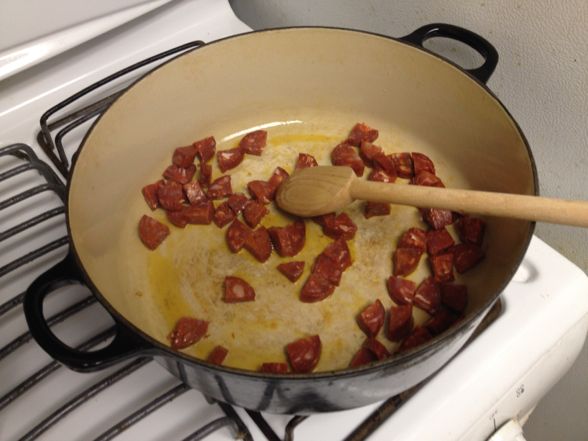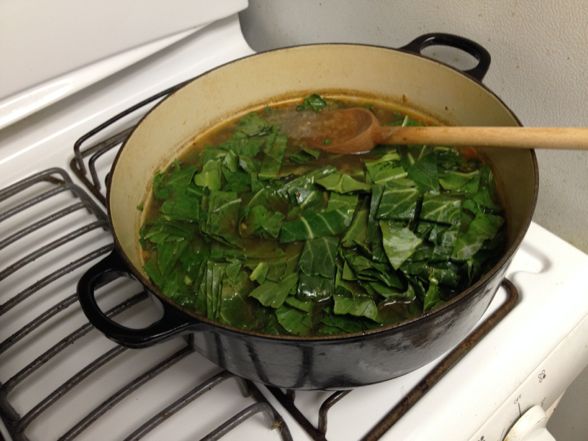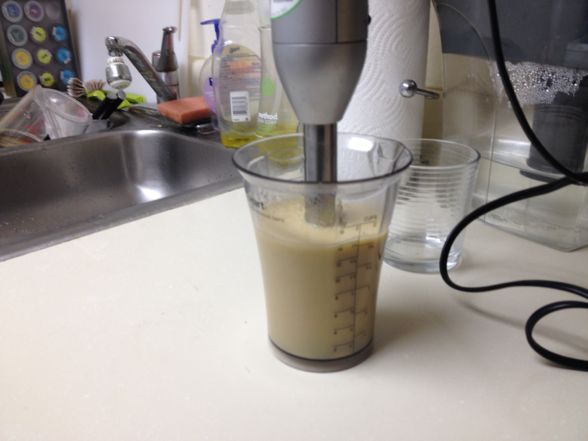What does one do with collard greens? Well, one usually makes collard greens. Yes, that signature soul food dish is probably the first thing that springs to most people’s minds, but here’s a fun twist: collard greens can also be used in the tasty Portuguese soup caldo verde. This is my awkward way of announcing that I’ve recently made both collard greens and caldo verde soup, and I deeply wish to share my experiences here on this blog.
Behold, if you will, a collard adventure for the ages.
First we’ll start with the classic collard greens. Over the summer, I attended a soul food birthday party (a.k.a. a birthday party with catered soul food, not a birthday FOR soul food — although, that would be fun). The plan was to have a huge spread from Dulans On Crenshaw, an artery-clogging institution here in LA, but as the price of the meal went up, certain dishes had to be cut. Long story short: there would be no collard greens.
Now, I’m not particularly a huge collard green enthusiast. I mean, I like them and all, but I personally would not care that the collard greens would be gone. However, I strangely felt bad that this signature soul food item would be missing from the party. They couldn’t be THAT hard to make; so as a little surprise, I set about making some collard greens.
My only problem: I had no IDEA how to make collard greens.
Luckily, I was still in the throes of a Southern food / Cajun obsession thanks to an April trip to New Orleans, and therefore I knew just where to turn for inspiration: Donald Link. The chef and founder of Cochon, an amazing restaurant in the heart of The Big Easy, Link has written a few cookbooks, including Real Cajun, a tome that my friend and cookbook authority Adam Roberts has raved about. I had been debating purchasing the book, and this was the perfect excuse to road test a Real Cajun recipe.

Things start in a great way with bacon and onions in a Dutch oven. Can’t go wrong with this combination (although, sadly, I had only three strips of bacon, not the four that the recipe called for. While I’m generally opposed to this annoying hipster trend of “Everything is better with bacon,” I will say that in this case, I knew that axiom was correct. Hopefully the skimpy bacon servings would past muster.)

Once things cooked down a bit and caramelized, I added garlic, salt, sugar, pepper, and hot sauce. Oh, and cider vinegar. Very important.

In go the collard greens. This was a point of MAJOR anxiety for me. The recipe called for two pounds of greens that would then be stemmed, but my greens were pre-chopped from a bag; so I was very concerned that there would be too many greens, thus destroying the precarious collards-to-bacon-to-sauce ratio. There was some serious nailbiting happening.

Thirty-five minutes later, this is how everything looked. It wasn’t incredibly saucy, and while it tasted nice, I felt it needed more of a punch; so I added more vinegar and hot sauce and simmered longer.
To be honest, I wasn’t entirely sure how the collard greens were supposed to taste. I’ve eaten them many times, but I had never really paid much attention to the flavor. In this case, I just seasoned until they were brightly acidic and tasty. In the end, the collard greens wound up in a lovely place, and I’m happy to report that they earned me major brownie points at the dinner. Apparently it was crazy ballsy for a white guy like me to make collard greens for a predominantly black crowd of people who I didn’t know. So… thanks, Donald Link!
But wait, there’s more!
Now with my first collard greens experience under my belt, it was time to seek other exciting, impossibly riveting uses for the bitter plant. Thankfully, my mother was on hand to provide the inspiration. Over the past few months, my mom has been raving about a caldo verde recipe she had found in Cook’s Illustrated, that meticulous and wonderful magazine that tests recipes over and over again until they reach perfection. Well, apparently the Cook’s Illustrated version of caldo verde is sensational, and who was I to deny my mother’s recommendation? Thus, I set out to make this Portuguese soup, which curiously called for collard greens (among other things).

We begin with some mis-en-place. In the bowl are some Yukon gold potatoes, diced up quite uniformly, if I do say so myself. The next bowl over features onion, garlic, salt, and red pepper flakes. Lastly, we have 8 oz. of Spanish chorizo, which is less than the recipe’s required 12 oz. Here we go again: more ratio anxiety.

First, I sauté the chorizo until it becomes crispy and slightly browned. It smells amazing, and I pat myself on the back for choosing such a wonderfully fragrant recipe. To be fair, I will self-congratulate myself any chance I get.

The Spanish chorizo, post-browning.

Meanwhile, I then sauté everything in the onion bowl, and after a few minutes, I add the contents of the potato bowl as well as a bunch of chicken stock (homemade!) and some water. Everything simmers until the potatoes are tender. Ten to fifteen minutes, in case you care. And I know you do.

Collard greens: my new old friend. This time I am careful to buy actual bunches of collard greens that I remove from the stems by hand. I will not inflame my ratio anxieties anew!

Before the collard greens go into the pot, I remove about three quarters of a cup of broth and three quarters of a cup of solids. We’ll get back to them in a moment, but spoiler alert — they’re in a blender jar.

Enter the greens (and the chorizo).

About ten minutes later, it’s time to purée the stuff in the blender jar. Somehow I find this deeply satisfying.

The purée goes back into the pot as well as some vinegar. And we’re done!
And how was this soup? It was really good! The vinegar and the sausage infuse the broth with a crazy tanginess that may perhaps be too aggressive for some. However, I came to the very important realization about a year ago that I love sour and tangy soups; so I was perfectly happy with the flavors. This is definitely a cold weather soup, but fear not — it works perfectly well in a heatwave (which is when I made it). My mother notes that it’s better with kale instead of collard greens as kale can be a bit more tender. I say use whatever greens you want. But do not subsitute Mexican (soft) chorizo for Spanish (hard, smoked) chorizo. Do not! Or else you will have failed at this recipe and perhaps at life.
Donald Link’s Smothered Collard Greens
Cook’s Illustrated Caldo Verde
What other uses do you find for collard greens?
